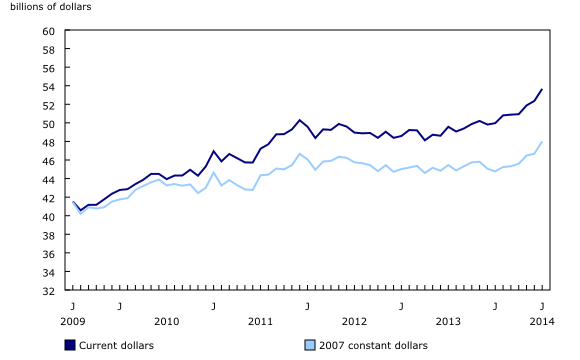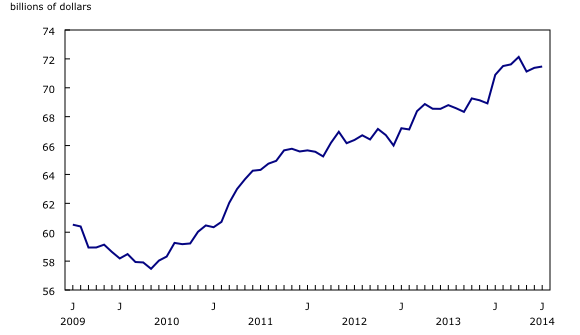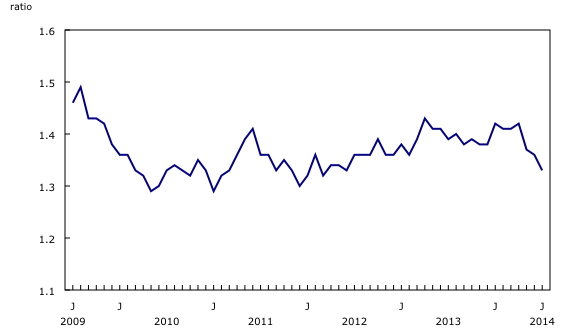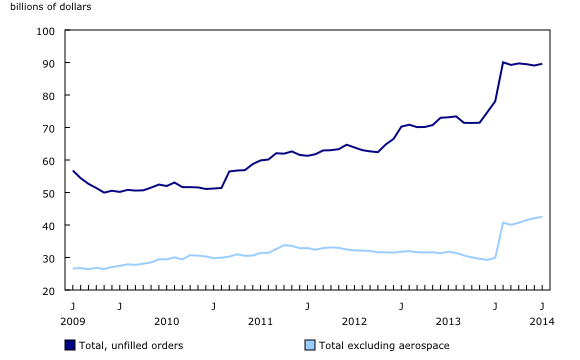Monthly Survey of Manufacturing, July 2014
Archived Content
Information identified as archived is provided for reference, research or recordkeeping purposes. It is not subject to the Government of Canada Web Standards and has not been altered or updated since it was archived. Please "contact us" to request a format other than those available.
Released: 2014-09-16
Canadian manufacturing sales increased 2.5% to $53.7 billion in July, exceeding the previous record of $53.2 billion set in July 2008. Manufacturing sales have trended upwards since January 2014. The gain in July was largely attributable to higher sales in the transportation equipment and primary metal industries.
Sales rose in 16 of 21 industries, representing about 56% of Canadian manufacturing.
Constant dollar sales rose 2.8% in July, indicating the gain was mainly due to a rise in volumes rather than prices.
Transportation equipment leads the gains
Transportation equipment sales rose 10.3% to $10.1 billion in July. The advance was mainly due to gains in the motor vehicle, aerospace product and parts, and other transportation equipment sub-industries.
In the motor vehicle sub-industry, sales increased 11.6% to $5.1 billion. Historically, most automotive plants have shutdowns in July. However, this year, several plants reported shorter or no shutdowns during July, which accounted for the stronger than normal month.
Primary metal sales rose 4.0% to $4.2 billion in July. Gains in the industry were widespread.
In July, five industries reported lower sales, with food manufacturing reporting the largest decrease, down 1.4% to $7.9 billion.
Sales gains concentrated in Ontario
While eight provinces posted higher sales in July, the bulk of the gain was in Ontario.
Sales in Ontario rose 4.2% to $25.0 billion in July. About 90% of the provincial gain stemmed from a 12.2% advance in the transportation equipment industry. Sales rose 3.9% in the primary metal industry and 4.4% in the fabricated metal product industry. A 3.6% decline in the food industry offset some of these gains.
The second largest gain for July was in Manitoba, where manufacturing sales rose 15.4% to $1.5 billion. Most of the gain reflected an increase in the transportation equipment and primary metal industries.
In Alberta, sales declined 0.8% to $6.9 billion. This was the second decline in seven months. Decreases in the petroleum and coal product and food industries were largely responsible for the provincial decline.
Inventories edge up
Inventory levels remained virtually unchanged in July, edging up 0.1% to $71.5 billion. Higher inventories held by manufacturers in the aerospace product and parts industry were almost completely offset by a decrease in the petroleum and coal product industry.
In the aerospace product and parts industry, inventories increased 4.6% to $8.2 billion. The gain was mostly the result of higher goods in process and finished products on hand.
In the petroleum and coal product industry, inventories fell 2.6% to $7.6 billion. A decrease in finished products held by manufacturers was the principal factor behind the decline, as several plants sold off excess inventories.
The inventory-to-sales ratio decreased from 1.36 in June to 1.33 in July. This was the lowest level since June 2012.
Unfilled orders rise
Unfilled orders rose 0.6% to $89.6 billion in July, following two months of slight declines. Advances in the computer and electronic product, transportation equipment, and primary metal industries were mainly responsible for the increase in July.
Unfilled orders in the computer and electronic product industry advanced 3.9% to $4.3 billion, the sixth consecutive monthly increase and the eighth gain in 10 months.
New orders rose 4.3% to $54.2 billion in July, mainly as a result of gains in the transportation equipment and primary metal industries.
Note to readers
Monthly data in this release are seasonally adjusted and are expressed in current dollars unless otherwise specified. For more information on seasonal adjustment, please refer to the following document: Seasonally adjusted data – Frequently asked questions
With this release, data have been revised for the previous three months.
Non-durable goods industries include food, beverage and tobacco products, textile mills, textile product mills, clothing, leather and allied products, paper, printing and related support activities, petroleum and coal products, chemicals, and plastics and rubber products.
Durable goods industries include wood products, non-metallic mineral products, primary metal, fabricated metal products, machinery, computer and electronic products, electrical equipment, appliances and components, transportation equipment, furniture and related products and miscellaneous manufacturing.
Production-based industries
For the aerospace industry and shipbuilding industries, the value of production is used instead of sales of goods manufactured. This value is calculated by adjusting monthly sales of goods manufactured by the monthly change in inventories of goods in process and finished products manufactured.
Unfilled orders are a stock of orders that will contribute to future sales assuming that the orders are not cancelled.
New orders are those received whether sold in the current month or not. New orders are measured as the sum of sales for the current month plus the change in unfilled orders from the previous month to the current month.
Manufacturers reporting in US dollars
Some Canadian manufacturers report sales, inventories and unfilled orders in US dollars. These data are then converted to Canadian dollars as part of the data production cycle.
For sales, based on the assumption that they occur throughout the month, the average monthly exchange rate for the reference month (noon spot rate) established by the Bank of Canada is used for the conversion. The monthly average exchange rate is available on CANSIM Table 176-0064.
Inventories and unfilled orders are reported at the end of the reference period. Therefore, for these variables, the noon spot exchange rate on the last working day of the month is used for the conversion. The noon spot exchange rate is available on CANSIM Table 176-0067. Note that because of exchange rate fluctuations, the monthly average exchange rate can differ substantially from the exchange rate on the last working day of the month.
Data from the August Monthly Survey of Manufacturing will be released on October 16.
Contact information
For more information, contact us (toll-free 1-800-263-1136; 514-283-8300; infostats@statcan.gc.ca).
To enquire about the concepts, methods or data quality of this release, contact Jeff Paul (613-951-7328; jeff.paul@statcan.gc.ca) or Elton Cryderman (613-951-4317; elton.cryderman@statcan.gc.ca), Manufacturing and Wholesale Trade Division.
- Date modified:





